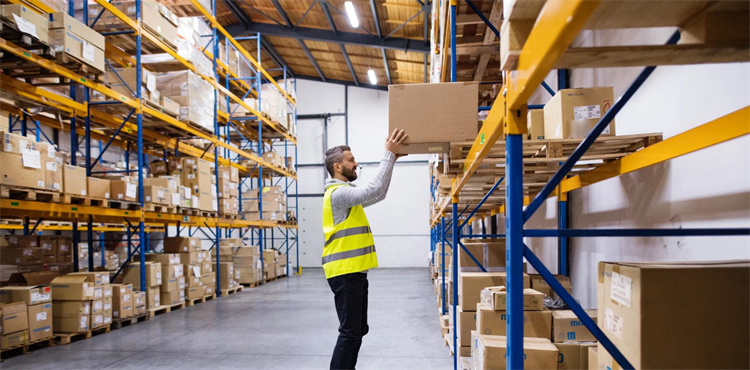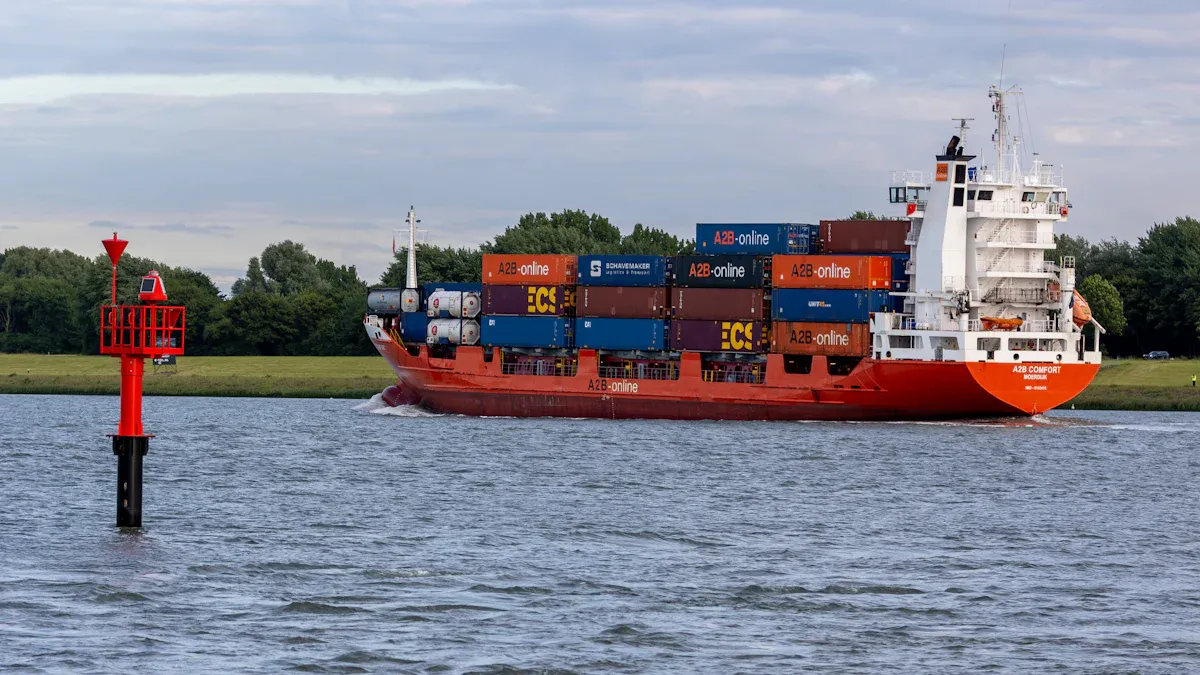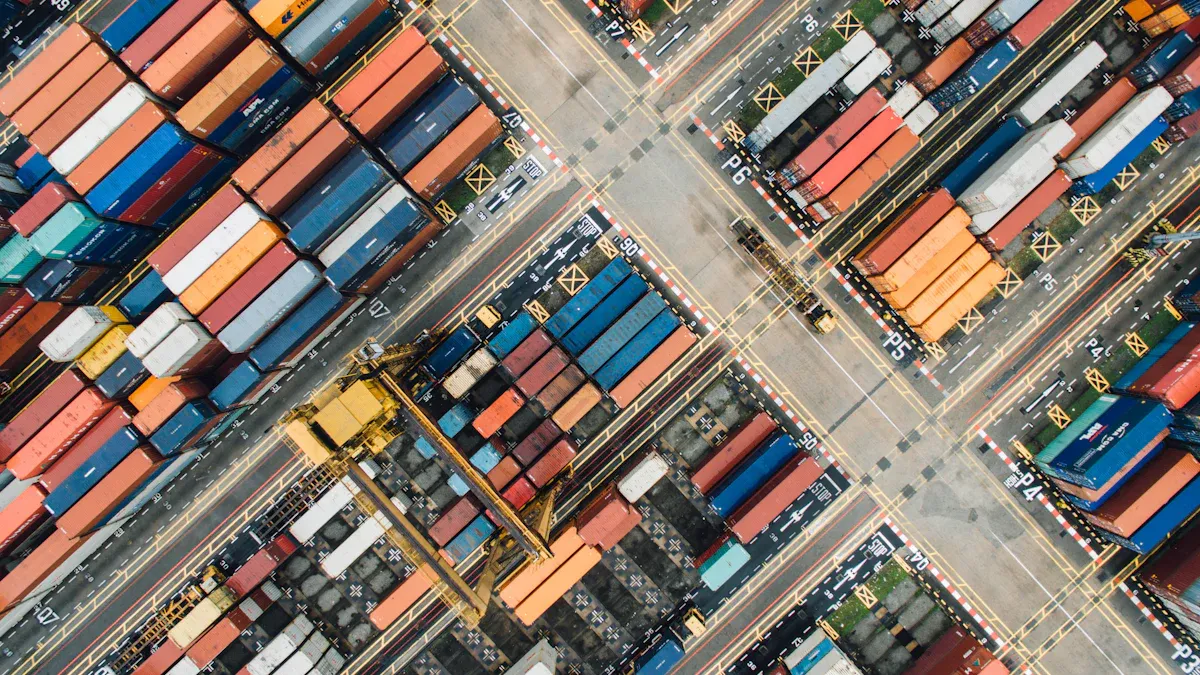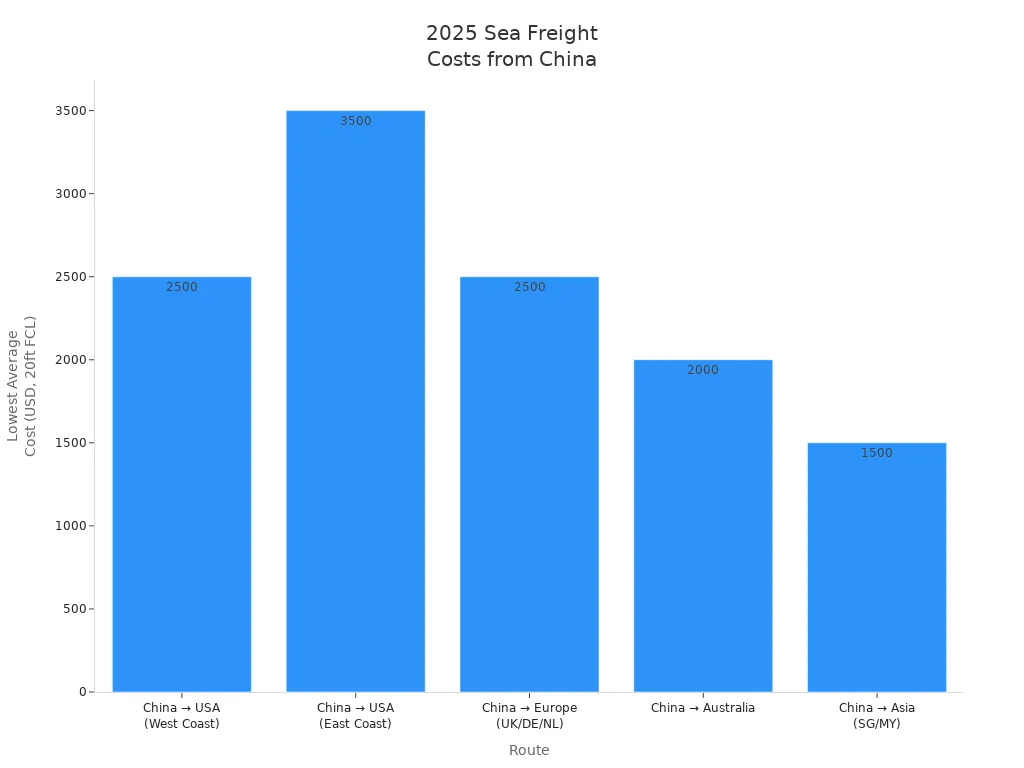Mastering International Shipping from China for Businesses in 2025

You can learn to handle international shipping from China in 2025 by using smart, legal, and money-saving ways. Fast shipping from China helps you save money, get products quickly, and grow your business around the world. JUSDA’s new services and shipping choices for China shipping demonstrate an effective approach to making international shipments work seamlessly in global trade.
Key Takeaways
Pick the best shipping way for your product size and how fast you need it. Air freight is quick but costs more. Sea freight is cheaper for big shipments.
Learn about customs rules and tariffs. Knowing these rules helps you stop delays and surprise costs.
Use tools like JUSDA’s JusLink AI Solution to watch shipments and handle risks. This helps things work better and keeps your business steady.
Shipping Strategies
China Shipping Overview
To ship from China in 2025, you must know the newest trends. Many companies now send big shipments to local warehouses. This is better than sending single packages. You can use sales deals to get customers to buy items already in the U.S. This helps you keep track of your stock and saves money.
Here is a table with the best ways to ship from China:
Strategy | Description |
|---|---|
Pick air freight or ocean freight. Think about your product’s size, weight, and how fast you need it. | |
Invest in Cargo Insurance | Get cargo insurance to protect your goods from loss while shipping. |
Understand Customs Regulations | Work with a customs broker. They help you follow import rules and laws. |
You should watch for new changes. U.S. tariff rules have made shipping cost more. Early busy season means higher freight rates. Not enough ships and equipment make prices go up. Changing shipping routes and higher fuel costs also raise your expenses.
Business Impact
Your shipping choices can change your business results. If tariffs go up, you pay more for inventory. You might make less money unless you charge customers more. Some businesses now buy from places other than China to save money. You may pay extra for storage if your products do not sell fast. Tougher checks can slow down restocking. You need to plan ahead and order early to handle these problems. If you learn how to ship from China and pick the best shipping options, your business can do well in global trade.
Shipping Methods

When you ship freight from China, you have many choices. Each shipping method has its own speed and cost. Some are better for certain types of goods. Knowing these choices helps you pick what is best for your business. Here is a quick look at the main shipping methods from China:
Shipping Method | Cost Range | Timeframe |
|---|---|---|
Rail Freight | $3,000–$5,000 | 12–20 days |
$12,000–$30,000 | 3–7 days | |
Ocean Freight (FCL) | Varies by container | Varies |
Ocean Freight (LCL) | Lower than FCL | Varies |
Air Freight
Air freight is the fastest way to ship goods. You get your items in 2 to 7 days. This method is also very reliable with fewer delays. You pay more for this speed, about $4 to $12 per kilogram. Air freight works best for expensive or urgent shipments. If you send big orders, your goods may be grouped together before flying. This method helps you control your stock and gives you more choices. You must follow strict packaging rules.
Advantages | Disadvantages |
|---|---|
Speed: Faster delivery times | Higher costs |
Reliability: Fewer delays | Environmental concerns |
Flexibility: More options | Stricter packaging requirements |
Improved inventory management | Potential delays due to weather/customs |
Sea Freight
Sea freight is the most common way to ship from China. You can use it for full containers or smaller loads. Sea freight is best for big, heavy shipments that do not need to arrive fast. It costs less than air freight, about $0.1 to $0.5 per kilogram. Shipping takes 15 to 45 days, depending on the route. For example, a 40-foot container to the U.S. West Coast takes 3 to 4 weeks and costs about $4,900. To the East Coast, it takes 4 to 6 weeks and costs about $6,600. Sea freight can have more delays, but it saves money for large shipments.
Rail Freight with JUSDA
JUSDA’s China-Europe Express Rail is a smart and new way to ship. This rail connects over 223 cities in Europe and more than 100 in Asia. Rail freight is faster than sea freight, taking 12 to 20 days. It costs much less than air freight, sometimes up to 50% less. Rail freight is also more reliable than sea or air because weather affects it less. It is better for the environment, cutting carbon emissions by about 30% compared to air freight. JUSDA’s network helps you reach new places and ship with confidence. Rail freight is good for electronics, clothes, and medical supplies.
Tip: If you want a shipping method that is fast and not too expensive, rail freight with JUSDA is a good choice for international trade.
Courier Services
Courier services like FedEx, UPS, DHL, and TNT are good for small packages and urgent shipments. You can get delivery in 1 to 4 days, depending on the service. Costs are $8 to $15 per kilogram for standard and $10 to $20 per kilogram for express. Courier services are best for samples, papers, or small orders that need to arrive quickly. You can also use special services for fragile or big items, with delivery in 2 to 5 days.
Use Case | Description | Delivery Time | Cost per KG |
|---|---|---|---|
Standard Delivery | Reliable transport of parcels and documents for general needs. | 1-4 days | 8-15 USD |
Express Services | Fast delivery options for urgent shipments. | 1-2 days | 10-20 USD |
Specialized Solutions | Tailored services for fragile or oversized items. | 2-5 days | 12-25 USD |
Door-to-Door Options
Door-to-door shipping makes freight shipping from China easy for you. The provider picks up, clears customs, and delivers to your address. This method saves money, keeps your goods safe, and is convenient. You do not have to handle each step yourself. But you may have fewer shipping choices and possible delays. There is also a higher chance of damage or loss, and some effect on the environment.
Benefits | Drawbacks |
|---|---|
Cost efficiency | Limited shipping options |
Increased security | Potential delays |
Personalized delivery | Higher risk of damages or loss |
Convenience for customers | Environmental impact |
Comparing Shipping Methods
You should compare speed, cost, and reliability when picking a shipping method. Here is a summary:
Freight Mode | Speed (Days) | Cost per KG (USD) | Reliability |
|---|---|---|---|
Sea Freight | 15-45 | $0.1 – $0.5 | High risk of delays |
Air Freight | 2-7 | $4 – $12 | Most reliable |
Rail Freight | 12-20 | $1 – $3 | Generally reliable |
Pick the shipping method that fits your product, budget, and delivery needs. If you want to ship from China with the best results, check your options and choose what works for your business. JUSDA’s services help you ship freight and stay ahead in international shipping.
Choosing the Best Option
Product and Volume
Pick a shipping method that fits your product and order size. Big or heavy shipments from China often use sea freight. Sea freight costs less but takes more time. Small, expensive, or breakable items may need air freight. Air freight is fast and keeps things safe, but it costs more. Rail freight is good if you want something between fast and cheap. It works well for shipping to Europe or Asia. Courier services are best for small packages or when you need things quickly.
Shipping Method | Ideal For | Characteristics |
|---|---|---|
Sea Freight | Large volumes, bulky items, non-urgent shipments | Economical but slower |
Air Freight | Smaller, high-value, or time-sensitive goods | Fastest option, higher costs |
Rail Freight | Medium-sized, time-sensitive shipments | Efficient for Europe and Asia |
Courier Services | Small parcels or urgent shipments | Door-to-door delivery with tracking |
Note: If your products can break or spoil, pick faster and safer shipping from China. If your goods last longer, you can use slower and cheaper shipping.
Urgency and Budget
Think about how fast you need your items and how much you want to spend. If you need things right away, pick air freight or courier services from China. These choices cost more but get your goods to you quickly. If you want to save money and can wait, sea freight is the cheapest way. Rail freight is a good middle choice for international shipping. It is not too slow or too expensive. Always think about how urgent your order is and how much you can spend. This helps you make smart choices for your business.
If you need things fast, pick quicker shipping.
If you have less money, choose cheaper shipping.
Finding the right mix helps your business do well in global trade.
Freight Shipping from China Costs

Understanding the costs of freight shipping from China helps you plan your budget and avoid surprises. You need to look at several parts of the total cost. Each part affects your final price when you use international shipping.
Shipping Fees
Shipping fees make up the largest part of freight shipping from China. The cost depends on the method you choose. Ocean freight is the most common for large shipments. Air freight works best for urgent cargo. Express shipping is fast but costs more. Here is a table to help you compare:
Shipping Method | Average Cost | Best For |
|---|---|---|
Sea Freight (20ft FCL) | $1,800 – $3,500 | Large shipments |
Sea Freight (40ft FCL) | $3,500 – $5,500 | Bulk shipments |
$4.5 – $9 per kg | Urgent cargo | |
Courier/Express | $25 – $45 per kg | Small parcels |
You can see that ocean freight is 4-6 times cheaper than air freight for big orders. Express shipping is 56% more expensive than standard air freight. Delivery times also change based on your choice.

Duties and Taxes
You must pay duties and taxes when you import goods. The rates depend on the product and the country. For example, the US uses different tariffs for steel, chemicals, and other goods. Some rates change during the year. Here is a quick look:
Tariff Type | Tariff Rate | Target Products | Effective Date |
|---|---|---|---|
Liberation Day | 34% → 10% | All (some exclusions apply) | April 2, 2025 (reduced rate effective May 14, 2025 – November 10, 2025) |
Section 232 | 50% | Steel, aluminum, autos, appliances | June 4, 2025 |
Section 301 Lists | 25% | Chemicals, machinery, textiles, more | 2018–2019 |
You need to check the Harmonized Tariff Schedule (HTS) code for your product. The declared value and country of origin also affect the duty.
Insurance and Packaging
Insurance protects your freight shipping from China against loss or damage. You pay a small percentage of your cargo’s value for this safety. Good packaging also matters. Lightweight materials can lower your shipping costs. Strong packaging keeps your goods safe and helps you avoid extra costs from damage or returns.
Insurance adds a small cost but gives peace of mind.
Smart packaging choices can save money and prevent damage.
Destination Charges
When your shipments arrive, you pay destination charges. These include import duties, taxes, and customs clearance fees. You also pay for handling and delivery. The product’s HTS code, declared value, and country of origin all play a role. Sometimes, you face extra fees for inspections or special processing.
Tip: Always ask your freight forwarder for a full breakdown of destination charges before you ship.
Shipping from China to the US Process
Shipping from China to the US in 2025 has many steps. You must follow each step to make sure your freight is safe and on time. JUSDA’s JusLink AI Solution lets you track shipments and manage risks. It helps you work faster and smarter during the whole process.
Preparation and Packing
First, you get your goods ready for freight shipping from China to the US. You need to pack items in strong boxes with clear labels. This keeps your products safe and follows shipping rules. Check the size and weight of every package. Make sure they fit the rules for international shipping. Good packing stops damage and saves you money.
Tip: Use good packing materials. This keeps your freight safe and helps you pass checks.
Documentation
You must collect all the papers needed for shipping from China to the US. You need a commercial invoice, packing list, and bill of lading. These show what you are shipping and who owns it. Some goods, like electronics or medical supplies, need special certificates. Having the right documents helps you clear customs fast and avoid waiting.
Check every paper before you send your freight. Mistakes in documents can slow your shipments and cost more money.
Customs Clearance
Customs clearance is an important part of shipping from China to the US. First, you give your documents to Chinese customs. You must follow export rules and pay fees. After your freight leaves China, it goes to the US. When it arrives, you clear US customs. You give import papers and pay duties or taxes. Customs officers check your papers and look at your goods.
JUSDA’s JusLink AI Solution helps you watch customs steps. You get updates and alerts right away. This helps you avoid delays and work better.
Feature | Description |
|---|---|
You see the latest info about your orders and shipments. | |
Inventory visualization | You check your inventory levels as they change. |
Customs monitoring | You follow customs steps to stay on track and avoid delays. |
Data analytics | You use data to make smart choices and work better. |
Integration of technologies | You use AI, IoT, and big data for risk control and faster work. |
Final Delivery
After customs, you set up the last delivery of your freight. You move goods from the port to your warehouse or customer. You can use trucks, courier services, or rail freight. JusLink’s AI Solution gives you tracking, so you always know where your shipments are. You get alerts if something goes wrong.
Many companies have made shipping from China to the US better with JUSDA’s smart tools. For example, Chinese manufacturers use JUSDA’s Supply Chain Management Collaboration Platform. This platform uses AI to manage freight and track shipments. It also cuts down on manual work. Companies save time and money. They also see and control their international shipments better.
Note: Always plan every step of your shipping from China to the US. Use smart tools like JusLink to work faster and avoid problems.
Here are the main steps in the shipping from China to the US process:
Get a shipping quote from your freight forwarder.
Book your shipment and set up pickup.
Pack and label your goods well.
Clear customs in China with the right papers.
Move your freight to the port and load it.
Watch your shipment during ocean travel.
Clear customs in the US and give import papers.
Deliver your goods to the final place.
You can get good at shipping from China to the US by following these steps and using smart services. JUSDA’s JusLink AI Solution helps you track, manage, and improve your freight shipments for better results.
Regulations and Compliance
Importing from China Rules
You have to follow many rules when importing from China in 2025. Customs duties and tariffs change by country and by your product’s HS code. The US will start a 10% tariff on all imports on April 5, 2025. If your goods are not worth much, you might not pay duties after May 2, 2025. You must show where your shipments come from, so keep your Certificate of Origin. The Uyghur Forced Labor Prevention Act stops goods from Xinjiang unless you prove no forced labor was used. Customs can check your records for five years. They look at how you classify, value, and follow the rules. Intellectual property rules are very strict. US Customs can take away products that break these rules. You should make sure your supply chain follows the rules to avoid problems and fines.
Key importing regulations to follow:
Watch tariff rates and customs duties.
Be ready for customs checks and save your records.
Do not import goods from banned regions.
Make sure you protect intellectual property rights.
Incoterms 2025
Incoterms 2025 will bring new rules for international shipping. You will use digital documents and blockchain, which help make importing faster and safer. There may be new rules about protecting the environment. E-commerce and drop-shipping rules may also change to fit new ways of trading. You should learn the new Incoterms so you do not make mistakes when shipping.
Incoterms 2025 Update | Impact on Importing from China |
|---|---|
Digital documentation | Faster and safer importing |
Blockchain integration | More clear information for shipments |
Sustainability guidelines | New rules for the environment |
E-commerce modifications | Easier online trade and drop-shipping |
Required Documents
You need many documents to follow the rules when importing from China. Each paper helps you clear customs and shows you meet shipping rules. Always check your documents before you send anything.
Essential documents for importing:
Commercial invoice
Packing list
Bill of lading
Certificate of origin
Marine insurance certificate
Importer Security Filing (ISF)
Customs bond
Arrival notice
Partner government agency certificates (if needed)
FDA certification for food and drugs
Declaration for dangerous goods
Test reports and wooden packaging declarations
Tip: Having the right documents helps you avoid customs delays and keeps your shipments moving.
Reliable Partners
Choosing JUSDA
You need a partner who knows how hard importing can be. JUSDA is special because it gives smart help for your business. You can use their worldwide network with more than 155 service points. JUSDA uses new technology to watch your shipments and lower risks. Their team has lots of experience moving goods from China. Many businesses, like electronics and car companies, trust JUSDA for shipping. You also get the JusLink platform, which shows updates and helps fix problems fast. JUSDA helps you at every step, from packing to clearing customs. You save time and make fewer mistakes with a partner who knows import rules.
Tip: Pick a partner who can handle tough importing jobs and gives great customer support.
Evaluating Forwarders
You must choose a forwarder who makes importing simple and safe. Use clear rules to compare your choices. Look for someone with experience, fair prices, and good service. Make sure the forwarder follows all the laws. Ask for reviews from other customers. Check if they help with customs clearance. Good talking is important. Always ask about extra fees before you agree.
Description | |
|---|---|
Experience | Find a forwarder with a strong history in importing. |
Pricing | Look for fair prices and no extra hidden fees. |
Service Levels | Pick a forwarder who answers fast and talks clearly. |
Legal Compliance | Make sure they have the right licenses and follow the rules. |
Recommendations and Reviews | Read what other importers say to see if they are reliable. |
Customs Clearance Assistance | Check if they can help with customs clearance for your shipments. |
You make smarter choices when you use these rules. A good partner helps your business grow in other countries.
Common Challenges
Delays and Disruptions
Shipping from China can have many delays. During Chinese New Year, workers take time off. This causes not enough people at work. Ports get very busy before and after the holiday. This makes it hard to move goods quickly. Sometimes, carriers change their schedules. This can make shipments late. If port workers and bosses do not agree on contracts, work slows down. In 2025, new U.S. tariffs may make shipping cost more. These changes can lower how much people buy from China. You need to plan ahead to handle these problems.
Not enough workers during holidays
Busy ports before and after big events
Carriers changing their schedules
Problems with contracts at ports
Tariffs making shipping more expensive
Damage Prevention
You must keep your shipments safe from damage. Use strong boxes and clear labels. Make sure your goods follow shipping rules. Pick the best packing for breakable things. Insurance helps if your goods get lost or broken. Check your packages before you send them. Good packing keeps your items safe and lowers your risk.
Tip: Always check your goods and use strong packing to stop damage when shipping far.
Communication Tips
Talking clearly helps you avoid mistakes. Speak with your shipping partners often. Share news about your shipments and ask questions if there are delays. Use tracking tools to watch your goods. JUSDA’s JusLink platform gives you updates and alerts right away. Good talking helps you fix problems fast and keeps your shipments moving.
Note: Keep in touch with your partners and use tracking tools to help your shipments arrive on time.
International Shipping Tips
Cost Savings
You can spend less money when shipping from China if you make smart choices. First, choose the shipping method that fits your needs. Sea freight is good for big shipments because it is cheaper. Air freight is faster but costs more money. Courier services are best for small and urgent packages.
Here are some ways to save money:
Pick the shipping method that matches your shipment size and how fast you need it.
Talk with freight forwarders to try to get lower prices.
Use good packaging so you can fit more items in each container.
Use bonded warehouses to wait before paying duties and help your cash flow.
Tip: Always ask for a few quotes before picking a shipping partner.
Compliance Best Practices
Following the rules helps keep your shipments safe and on time. Check all your documents before you ship from China. Make sure you have the right invoices, packing lists, and certificates. Learn about new rules for international shipping, like Incoterms 2025. Protect your business by following customs laws and saving records for every shipment.
A simple checklist helps you follow the rules:
Step | Action |
|---|---|
Prepare Documents | Check invoices and certificates |
Know Regulations | Learn new rules and tariffs |
Keep Records | Save all shipping paperwork |
Streamlining Operations
You can make shipping easier by using technology. Tools like JusLink let you track your shipments and manage risks. Shipping management software helps you avoid mistakes and work faster. Combine shipments when you can to save time and money.
Stay in contact with your partners and use real-time tracking to find problems early. This helps you deliver goods faster and keeps your customers happy.

JUSDA Solutions
To provide you with professional solutions and quotations.
You can get really good at shipping from China if you plan ahead. Try using different ways to ship your goods. Work with partners you trust, like JUSDA. Here is a simple checklist to help you keep your shipments moving:
Use different shipping methods.
Choose which shipments are most important by SKU.
Set up inspections early.
Keep your products near your customers.
Work with more than one logistics partner.
Keep learning about new shipping rules and changes in logistics.
See Also
Transforming Future Logistics Through Artificial Intelligence Innovations
Addressing Global Supply Chain Growth Issues in Today's Market
Exploring Innovations in Sea Freight Logistics for 2024
Enhancing Global E-commerce Through Supply Chain Transparency
Navigating Future Logistics Using Advanced Digital Technologies
